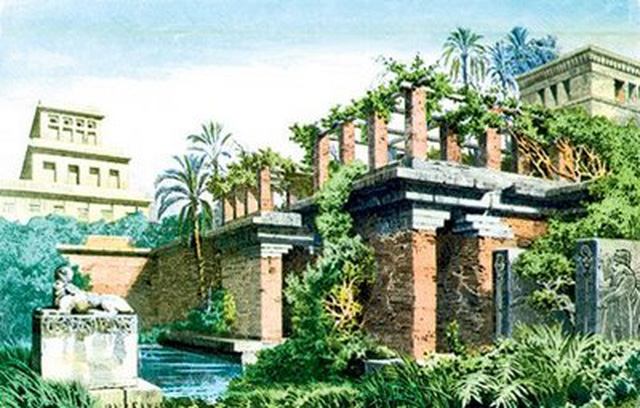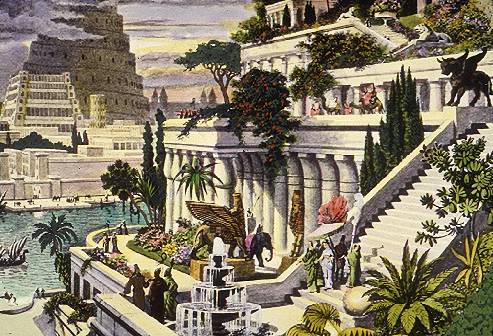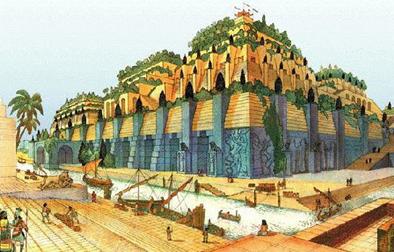Hanging Gardens of Babylon - Green paradise in the air
According to legend, the Hanging Gardens of Babylon were a special gift from King Nabuchadnezzar (605-562 BC) of the Chaldean dynasty of Babylon to his favored queen, the princess of the Medes. Emperor Nabubuchadnezzar.
Emperor Nabubuchadnezzar.
The Hanging Gardens were built to help Nebuchadnezzar's wife, Amyitis, relieve her nostalgia for her homeland. Amyitis was the daughter of the king of the Medes, who married Nebuchadnezzar to create an alliance between the two countries. Her homeland was a green land with majestic mountains, and she considered the flat, sun-scorched land of Mesopotamia (a region in southwest Asia) boring. The king decided to recreate the queen's homeland by building an artificial mountain area with hanging gardens on the roof.
The Hanging Gardens of Babylon were built right next to the king's palace, on the banks of the Euphrates River in the Mesopotamian basin, 50 km south of Baghdad, Iraq.
The garden has enough fragrant flowers, strange grasses, and rare plants brought from the areas the king invaded. In the hanging garden there is a fountain system consisting of two large wheels linked together by chains with wooden barrels attached. When the wheel rotates, the chain and water tank also move, bringing water from a tank below to the top to water the plants. To water the garden's flowers and plants, slaves had to take turns bringing water from the Euphrates River to the garden. Water is taken from 3 wells with rotating hydraulic machines with a bucket system that raises water to flow in gentle grooves to irrigate the entire garden. Because the garden is built in the direction of the wind, the fragrance spreads over a large area.
To water the garden's flowers and plants, slaves had to take turns bringing water from the Euphrates River to the garden. Water is taken from 3 wells with rotating hydraulic machines with a bucket system that raises water to flow in gentle grooves to irrigate the entire garden. Because the garden is built in the direction of the wind, the fragrance spreads over a large area.
The first person to mention the hanging gardens was Berossus, a reputable Babylonian historian who wrote about the hanging gardens around 270 BC. He said that King Nebuchadnezzar built a new palace in 15 days, with a stone foundation or terraced grounds like a mountain landscape. The Greeks later added more details. One theory says that the garden is 120 m2 wide, the height of the city wall is about 25 m high. The garden has a terrace shaped like a theater, with small works blending inside.
The Greeks later added more details. One theory says that the garden is 120 m2 wide, the height of the city wall is about 25 m high. The garden has a terrace shaped like a theater, with small works blending inside.  The foundation is built with many walls, each about 7 m wide and 3 m apart, to support stone beams. Above the beam are three separate layers - reeds set in a layer of asphalt, two layers of brick masonry, and an outer shell made of lead. The soil in the garden is placed at the top, water for the plants comes from camouflaged machines that suck water from the river flowing below.
The foundation is built with many walls, each about 7 m wide and 3 m apart, to support stone beams. Above the beam are three separate layers - reeds set in a layer of asphalt, two layers of brick masonry, and an outer shell made of lead. The soil in the garden is placed at the top, water for the plants comes from camouflaged machines that suck water from the river flowing below. A second theory is that the garden is located on arched roofs made of brick and asphalt: Archimede-style screws are located along the water supply stairs. Another description suggests that there was an outbuilding consisting of stone columns supporting wooden beams: beams made of palm tree trunks. Instead of rotting, it brought nutrients to nourish the roots of plants in the hanging area above, the entire campus was irrigated by a system of cleverly designed sprinklers and troughs.
A second theory is that the garden is located on arched roofs made of brick and asphalt: Archimede-style screws are located along the water supply stairs. Another description suggests that there was an outbuilding consisting of stone columns supporting wooden beams: beams made of palm tree trunks. Instead of rotting, it brought nutrients to nourish the roots of plants in the hanging area above, the entire campus was irrigated by a system of cleverly designed sprinklers and troughs. Although there is still much debate about its shape and characteristics, the Hanging Gardens of Babylon marked a golden age in the history of Mesopotamia, a period of brilliant development of the Chaldean kingdom, also known as New Babylon. King Nabuchadnezzar ruled the country for 44 years before passing away. After that, the Hanging Gardens of Babylon also faded away.
Although there is still much debate about its shape and characteristics, the Hanging Gardens of Babylon marked a golden age in the history of Mesopotamia, a period of brilliant development of the Chaldean kingdom, also known as New Babylon. King Nabuchadnezzar ruled the country for 44 years before passing away. After that, the Hanging Gardens of Babylon also faded away.





































